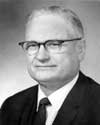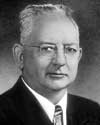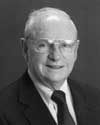J.C. Dingwall

J.C. Dingwall came to work for the Texas Highway Department in 1928 in Abilene. He would finish his career with the Department by serving as State Highway Engineer from 1968 until his retirement in 1973.
Dingwall left the Department during the Second World War to work with the Army Corps of Engineers building airfields around the world. In 1947 he rejoined the Highway Department and directed construction of the Gulf Freeway, the first urban expressway built in Texas. Dingwall moved to Austin in 1950 to head the Road Design Division.
In 1954, Mr. Dingwall was asked to become Engineer-Manager for the Texas Turnpike Authority, charged with building the Dallas-Fort Worth Turnpike. The entire project, including design, ROW acquisition and construction was completed in 3 years. The bonds were retired 17 years ahead of schedule.
Mr. Dingwall returned to the Highway Department in 1958 as Assistant State Highway Engineer. Greer handpicked Dingwall to head the Department in 1968. Under Dingwall the Department had as many as 20,500 employees, as the push to complete the interstate highway system continued. J.C. Dingwall served as President of AASHTO in 1972.
Ernest E. Howard

When Ernest Howard (UT 1900) began his career with the Kansas City bridge design firm of Waddell & Hedrick, he also embarked on a career that would help revolutionize transportation in America and leave a legacy of technical excellence and innovation. Never losing his connection to Texas, he designed many bridges in the state, including the landmark Congress Avenue Bridge in Austin. In 1914, Mr. Howard became a partner in the firm Harrington, Howard & Ash; in 1940, the firm became Howard Needles Tammen & Bergendoff (HNTB). Today, HNTB Corporation ranks among the top transportation infrastructure firms in Texas and the nation.
Mr. Howard’s technical excellence and innovation have been recognized in many ways. In 1921, Mr. Howard received the American Society of Civil Engineers’ prestigious Thomas Fitch Rowland Prize. In 1949, President Harry Truman appointed him to assist the Special Commission on the Renovation of the White House. Since 1954, ASCE has annually awarded the Ernest E. Howard Award for significant contribution to the advancement of structural engineering. In 2004, the American Road and Transportation Builders Association named Mr. Howard one of the Top 100 Private Sector Transportation Construction Professionals of the 20th Century.
Marcus L. Yancey, Jr.

Marcus Yancey, Jr. (UT ’50) joined the Texas Highway Department in 1957. He would spend the remainder of his career with the Department, retiring in 1993.
In 1967, Dewitt Greer transferred Yancey to his personal staff. Five years later, Marc was named Assistant Engineer-Director, and in 1980 he became Deputy Executive Director.
Known as a person of high integrity, Mr. Yancey represented the Department’s interests during 16 legislative sessions under eight governors. Marc Yancey was an effective manager and public spokesman for the Department. His management skills were recognized when he was called upon to chair the Governor’s Task Force on Management by Objectives in 1979. His strong financial oversight skills led him to be twice appointed as chairman of the State Agency Coordinating Council, and he was twice elected to the board of the State Employees Retirement System.
Mr. Yancey chaired numerous AASHTO committees, and was recognized as “Public Administrator of the Year” by the Austin Society of Public Administrators. Referring to Mr. Yancey, former Governor Briscoe noted: “Working with leaders such as Dewitt Greer, Marc was the key in building the best highway system to be found anywhere…”